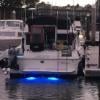Most wire sizing tables and calculators rate the wire for the max steady state current it can handle without overheating and causing damage. However, most charging scenarios involve high current flow for only a short period of time, maybe 10's seconds to a couple of minutes.
if you consider Joule heating and the damage threshold of the wire then for a given starting temperature and a max allowable wire temperature along with a given current load a time can be calculated during which the wire can handle higher current.
For example; Assuming a 28 C (82 F) starting temp and a max allowable temp of 80 C (176 F) 6 ga is good up to 70 amps for about 5 minutes before it gets hot enough to damage the wire. It is good up to about 11 minutes with a steady 50 A current flow.
Even though Jumper cables may carry 150 amps or more for a short period of time they are often made of 6 ga or 4 ga wire for this reason.
So the best question is what is the max current flow produced and over what duration. Knowing that one can appropriately size the wire without running heavy cable.
That written another factor is voltage drop which depends on wire size and wire length. A wire needs to be sized large enough so that the voltage drop does not create a problem for the battery being charged.
For Lead acid batteries need the bulk and absorption voltages typically vary between 14.0 and 14.8 V, and the float can vary between 13.2 and 13.8 V.
For LiFePO4 bulk/absorption voltages between 14.2 and 14.6 Volt will work! Lower is possible too, down to about 14.0 Volt, with the help of some absorb time. According to literature the BMS for most LiFePO4 batteries will allow around 14.8 - 15.0 Volt before disconnecting the battery.
For a 20 foot one way distance 6 ga wire will result in about a 0.4 V drop. If your source voltage is 15 V then the charge voltage will be 14.6 V.
I think voltage drop dictates the minimum wire size for most charging applications and 6 ga seems to be the appropriate minimum size.
https://grealpha.com...c/voltage-drop/
I see that the Redarc BCDC1250D puts out 50 A at a max of 15.3 V. So you need wire large enough to handle 50 A steady state (min 4 ga but that is the limiting current so the wire will run hot. Therefore, I would use 2 ga).
The Redarc BCDC1225D puts out 25 A at a max of at a max of 15.3 V. So you would need at least 4 ga.
Victron has 18, 20, and 30 Amp continuous output DC-DC chargers (Orion) that put out up to 15 V. I think 4 ga is the minimum wire size appropriate for these too.
All these wire size minimums are based on the Joule Heating calculator or the wire size calculator (see links).
Ref:
https://www.nepsi.co...kkvYx6v_5_dDLp0
I hope this is helpful.
Craig
Edited by ckent323, 25 May 2022 - 04:11 AM.


















